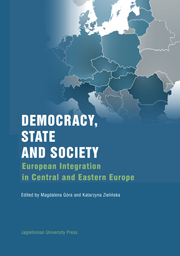Book contents
- Frontmatter
- Contents
- List of contributors
- Europeanisation in the EU New Member States. Aspects and Research Agendas
- Part one Democracy after Enlargement
- Part two Identity Transformations
- The Identity of Europeans after the EU Enlargement
- Peripheries and Borders in a Post-Western Europe
- Between Reconciliation and the Reactivation of Past Conflicts in Europe: Rethinking Social Memory Paradigms
- How Different is the “New Europe”? Perspectives on States and Minorities
- Part three Civil Society Organisations in Central and Eastern Europe
- Part four Europeanisation of International Relations
- Index
How Different is the “New Europe”? Perspectives on States and Minorities
from Part two - Identity Transformations
Published online by Cambridge University Press: 05 September 2014
- Frontmatter
- Contents
- List of contributors
- Europeanisation in the EU New Member States. Aspects and Research Agendas
- Part one Democracy after Enlargement
- Part two Identity Transformations
- The Identity of Europeans after the EU Enlargement
- Peripheries and Borders in a Post-Western Europe
- Between Reconciliation and the Reactivation of Past Conflicts in Europe: Rethinking Social Memory Paradigms
- How Different is the “New Europe”? Perspectives on States and Minorities
- Part three Civil Society Organisations in Central and Eastern Europe
- Part four Europeanisation of International Relations
- Index
Summary
Abstract: The new members of the European Union have embraced many characteristics of the Union's older members. In respect to what might be described as conceptions of the nation, one senses persistent differences. These come out most apparently in attitudes and policies towards both traditional and immigrant minorities. The new EU members have displayed extreme reluctance to countenance state-wide multilingualism, federalist arrangements, or, indeed, any form of territorial autonomy for historic minorities, in contrast to recent accommodation patterns in the old EU. This article argues that this reluctance may be attributed to state fragility, historically founded on the relatively brief and, in most cases, interrupted state-hood of the new EU members.
The article further suggests that isolation in the communist period and the absence of an overseas imperial legacy have left the new EU members without the experience of a non-European minority immigrant population. As a result, these countries' sense of national identity has not yet been challenged by the need to position themselves vis-à-vis non-Europeans. In the face of such inevitable future challenges, these countries may be expected to resist multicultural claims and to re-affirm their commitment to national homogeneity, thus demarcating themselves further from older EU members.
- Type
- Chapter
- Information
- Democracy, State and SocietyEuropean Integration in Central and Eastern Europe, pp. 147 - 168Publisher: Jagiellonian University PressPrint publication year: 2011



